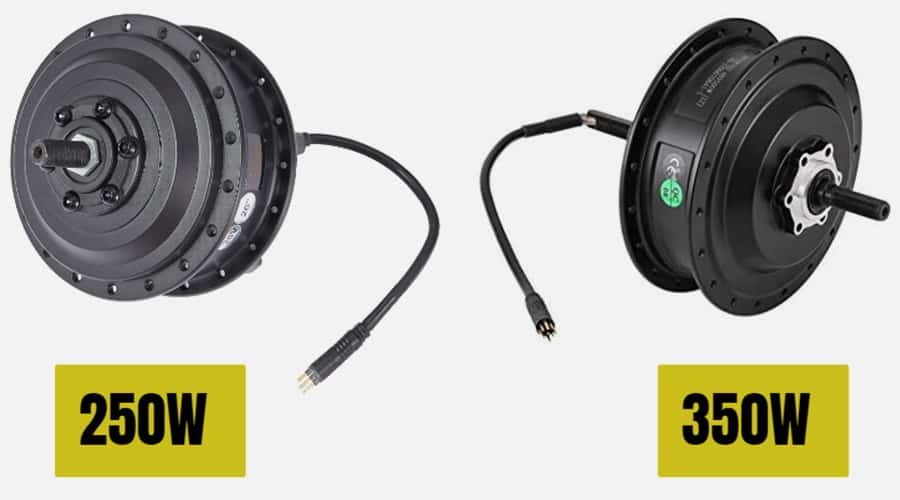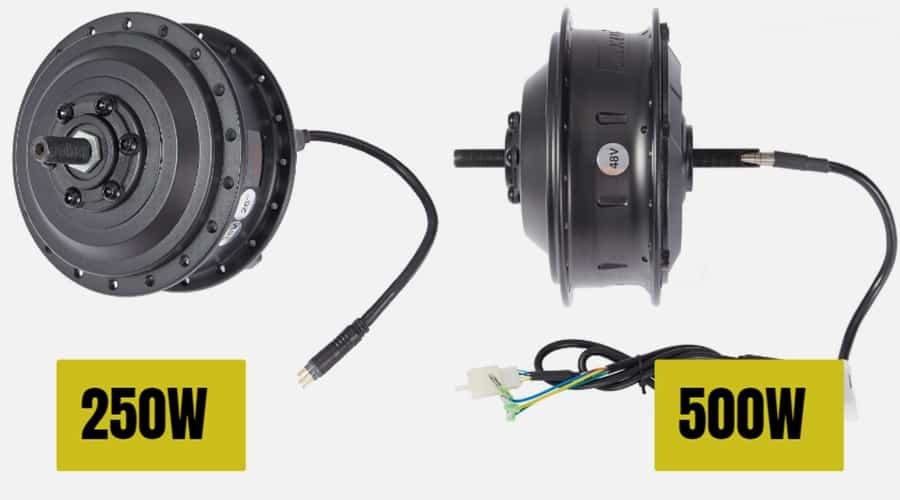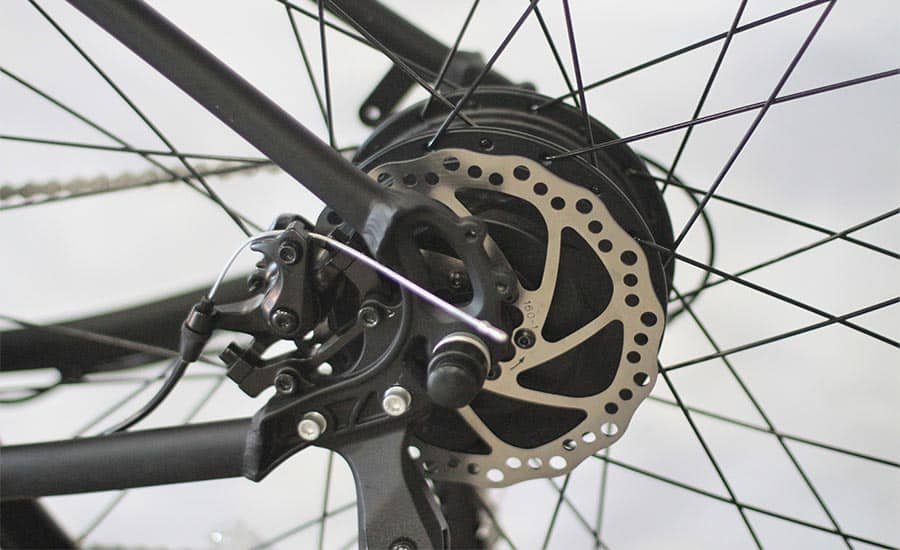Are you ready to take the leap into the world of e-bikes but feeling overwhelmed by the variety of options available? One of the most important considerations is the size of the motor, which directly affects the bike’s speed, power, and range.
However, selecting the right motor size for an e-bike can pose a difficult task for many individuals. Numerous factors must be taken into account, including riding requirements, terrain, and financial constraints, making it a challenging endeavor to pinpoint the ideal motor size.
In this post, we’ll provide you with expert insights and guidance on how to determine what size e-bike motor you need, so you can ride with confidence and enjoyment.
So, whether you’re looking for a boost on your daily commute or an adrenaline rush on the trails, read on to learn everything you need to know about e-bike motors.
What is a Good Size Motor for an E-bike?

E-bike motors come in various sizes, typically ranging from 250 watts to 1000 watts. The motor size directly affects the power, speed, and range of the e-bike. A higher wattage motor will provide more power and speed, but it will also drain the battery faster and can be heavier.
A 250-watt motor is a good size for most riders who use their e-bike for daily commuting or recreational riding on flat to moderate terrain. It provides enough assistance to make riding easier and more enjoyable without draining the battery too quickly.
If you plan on riding on steeper hills or off-road terrain, a more powerful motor may be necessary. A 500-watt motor or higher can provide enough power to tackle challenging terrain, but it may also be heavier and more expensive.
Keep in mind that the motor size is not the only factor that determines the performance of an e-bike. The quality of the battery, controller, and other components can also affect the overall performance and efficiency of the bike.
When choosing an e-bike motor size, it’s important to consider your riding needs and preferences. Think about the type of terrain you’ll be riding on, the distance you plan to travel, and your desired level of assistance. By selecting the right motor size, you can ensure a more enjoyable and efficient e-bike experience.
Factors to Consider When Choosing an Ebike Motor Size

When choosing an e-bike motor size, there are several factors to consider. Here are some of the most important ones:
🔲 Riding Needs: The motor size you choose should be determined by the type of riding you plan to do. If you plan to use your e-bike for commuting or leisurely rides on flat terrain, a smaller motor size (250-500 watts) may suffice. However, if you plan to tackle steep hills or ride off-road, you may need a larger motor size (500-1000 watts) to provide enough power and torque.
🔲 Terrain: The terrain you plan to ride on is a critical factor when choosing the motor size. Riding on hilly or mountainous terrain requires more power and torque than riding on flat terrain. In general, the steeper the hill, the more power you will need from your e-bike motor.
🔲 Rider Weight: Your weight is also a crucial factor to consider. Heavier riders may require a larger motor to provide the same level of assistance as a lighter rider. A larger motor can also help compensate for the added weight of cargo or accessories.
🔲 Battery Capacity: The motor size you choose will affect the battery capacity you need. A larger motor will consume more battery power, which means you may need a larger battery to provide sufficient range.
🔲 Budget: E-bike motors come in a range of sizes and prices. Larger motors are generally more expensive, so you should consider your budget when choosing a motor size. Keep in mind that investing in a more powerful motor can be worth it if it provides a better riding experience.
In summary, choosing the right motor size for your e-bike requires careful consideration of your riding needs, terrain, weight, battery capacity, and budget. By taking these factors into account, you can select a motor size that provides optimal performance and efficiency for your e-bike.
What is the Difference Between a 250W and 350W Motor?

The main difference between a 250W and a 350W e-bike motor is the amount of power they can deliver. A 350W motor is generally more powerful and provides more assistance than a 250W motor.
The 250W motor is the standard size for most e-bikes, and it provides enough power to assist the rider on flat or moderately hilly terrain. It’s ideal for commuting or leisurely rides, providing an average speed of around 15-20 mph. The 250W motor is also more energy-efficient, which means it consumes less battery power, providing longer range.
On the other hand, a 350W motor is more suitable for riders who need extra power to tackle steeper hills or more challenging terrain. It can provide a higher top speed and faster acceleration than a 250W motor. However, it consumes more battery power, which means it provides a shorter range than a 250W motor.
In general, a 350W motor is a good choice for riders who need more power and speed but are willing to trade off some range. A 250W motor is suitable for most riders who need assistance on flat or moderately hilly terrain and want to maximize their battery range. Ultimately, the choice between a 250W and a 350W motor will depend on your riding needs and preferences.
What is the Difference Between 250W and 500W Electric Bike?

The main difference between a 250W and a 500W e-bike is the amount of power that the motor can deliver. A 500W motor is more powerful than a 250W motor and can provide more assistance to the rider, particularly when climbing hills or riding in difficult terrain.
Here are some other differences between a 250W and a 500W e-bike:
🔲 Speed: A 500W motor can provide a higher top speed than a 250W motor. A 250W motor typically provides an average speed of around 15-20 mph, while a 500W motor can provide a top speed of up to 25 mph.
🔲 Acceleration: A 500W motor can provide faster acceleration than a 250W motor, which means you can get up to speed more quickly.
🔲 Range: A 500W motor consumes more battery power than a 250W motor, which means it provides a shorter range. However, the exact range will depend on several factors, including the battery capacity, rider weight, terrain, and level of assistance used.
🔲 Weight: A 500W motor is generally heavier than a 250W motor, which can affect the overall weight and handling of the e-bike.
In summary, a 500W e-bike is more powerful than a 250W e-bike and can provide more assistance to the rider. It can reach higher speeds and provide faster acceleration, but it may have a shorter range and may weigh more than a 250W e-bike.
The choice between a 250W and a 500W e-bike will depend on your riding needs and preferences, including the type of terrain you plan to ride on, the distance you need to travel, and your desired level of assistance.
What is the Difference Between 750W and 500W Ebike?

The key distinction between an e-bike with a 750W motor and one with a 500W motor is the motor’s capacity to generate power. A 750W motor is more powerful than a 500W motor and can provide even more assistance to the rider, particularly when climbing hills or riding in difficult terrain.
Here are some other differences between a 750W and a 500W e-bike:
🔲 Speed: In general, a 750W e-bike will be capable of achieving higher speeds than a 500W e-bike due to its more powerful motor. However, the maximum speed that an e-bike can reach is typically limited by law in most countries, and it is often around 20-28 miles per hour (32-45 km/h) regardless of the motor power.
Therefore, the actual difference in speed between a 750W and a 500W e-bike may not be very significant, and it may depend on the specific circumstances in which they are used.
A 500W motor typically provides an average speed of around 20-25 mph, while a 750W motor can provide a top speed of up to 28 mph or even higher.
🔲 Acceleration: A 750W motor can provide faster acceleration than a 500W motor, which means you can get up to speed more quickly.
🔲 Torque: A 750W motor can produce more torque than a 500W motor, which means it can provide more power for hill climbing or carrying heavier loads.
🔲 Battery consumption: A 750W motor consumes more battery power than a 500W motor, which means it provides a shorter range per charge. However, the exact range will depend on several factors, including the battery capacity, rider weight, terrain, and level of assistance used.
🔲 Legal restrictions: In some jurisdictions, e-bikes with motors larger than 750W are considered mopeds or motorbikes and may be subject to different regulations, such as requiring a license or registration.
In summary, a 750W e-bike is more powerful than a 500W e-bike and can provide more assistance to the rider, particularly for climbing hills or carrying heavier loads.
It can reach higher speeds and provide faster acceleration, but it may have a shorter range and be subject to different regulations in some jurisdictions. The choice between a 500W and a 750W e-bike will depend on your riding needs and preferences, including the type of terrain you plan to ride on, the distance you need to travel, and your desired level of assistance.
Is a Higher Watt Motor More Powerful?

Generally speaking, a higher watt motor is more powerful than a lower watt motor. The wattage rating of an electric bike motor is a measure of its power output, which indicates how much assistance it can provide to the rider.
The power output of an e-bike motor is determined by several factors, including the number of watts, the voltage of the battery, and the motor’s design and construction. A higher watt motor can provide more power and torque, allowing it to assist the rider more effectively, especially when riding uphill or carrying heavier loads.
However, it’s important to note that the power output of an e-bike motor is not the only factor that determines its performance. Other factors, such as the motor’s efficiency, gearing, and controller settings, can also affect how much assistance it provides and how it performs in different situations.
So while a higher watt motor is generally more powerful, it’s not the only factor to consider when choosing an e-bike. It’s important to consider your specific needs and riding conditions, as well as other factors like battery life and weight, when selecting an e-bike with the right motor for you.
The Legal Restrictions on Ebike Motor Size in Different Jurisdictions

The legal restrictions on e-bike motor size can vary depending on the jurisdiction. In general, there are three categories of e-bikes based on their maximum motor output:
Class 1 e-bikes have a motor that provides assistance only when the rider is pedaling and cuts off at a speed of 20 mph (32 km/h). The motor output is typically limited to 750 watts in most countries.
Class 2 e-bikes have a throttle that can be used to propel the bike without pedaling, but still cuts off at a speed of 20 mph (32 km/h). The motor output is typically limited to 750 watts in most countries.
Class 3 e-bikes have a motor that provides assistance only when the rider is pedaling and cuts off at a speed of 28 mph (45 km/h). The motor output is typically limited to 750 watts in most countries.
It’s important to note that these regulations can vary by jurisdiction, so it’s important to check the specific laws in your area. In some places, the maximum motor output for e-bikes may be lower than 750 watts, or there may be additional restrictions on other aspects of the e-bike’s design, such as its weight, speed, or braking system.
In some jurisdictions, e-bikes with motors that exceed the legal limits are classified as mopeds or motorbikes and may require a license or registration to operate. In other cases, they may be prohibited altogether.
In summary, the legal restrictions on e-bike motor size can vary depending on the jurisdiction, but in most places, the maximum motor output is limited to 750 watts. It’s important to check the specific regulations in your area to ensure that your e-bike complies with local laws and regulations.
FAQs
Is 250 watts enough for an ebike?
A 250W motor can provide sufficient power for an e-bike, especially for flat terrain or gentle slopes. However, for steeper inclines or heavier loads, a more powerful motor may be necessary.
Can 250W electric bike go uphill?
Generally, a 250W electric bike can go uphill, but its ability to climb steep hills may be limited compared to more powerful e-bikes. The rider may need to provide more pedal power or use lower gears to assist the motor on uphill sections.
Is 350 watts good for an ebike?
A 350W motor can provide good power and torque for an e-bike, making it suitable for climbing hills and carrying heavier loads. However, the performance will depend on other factors such as the bike’s weight, gearing, and rider input.
How fast is 350W?
The speed of a 350W e-bike will depend on various factors such as the bike’s weight, aerodynamics, and terrain. Generally, a 350W e-bike can reach speeds of up to 20 mph (32 km/h) or slightly higher, but this may vary.
How fast does a 500W ebike go?
A 500W e-bike can reach speeds of up to 28 mph (45 km/h) on flat terrain, but the actual speed will depend on various factors such as the bike’s weight, rider input, and terrain.
Is 750 watts good for an ebike?
A 750W motor is considered a high-power motor and can provide good power and torque for an e-bike, making it suitable for steep hills and carrying heavier loads. However, it may not be legal in all jurisdictions, and the performance will depend on other factors such as the bike’s weight and gearing.
How fast can a 750W ebike go?
The speed of a 750W e-bike will depend on various factors such as the bike’s weight, aerodynamics, and terrain. Generally, a 750W e-bike can reach speeds of up to 28 mph (45 km/h) on flat terrain or slightly higher.
How fast does a 1000W electric bike go?
A 1000W electric bike can reach speeds of up to 30-35 mph (48-56 km/h) on flat terrain, but the actual speed will depend on various factors such as the bike’s weight, rider input, and terrain.
How fast does a 2000W electric bike go?
A 2000W electric bike can reach speeds of up to 40-45 mph (64-72 km/h) on flat terrain, but the actual speed will depend on various factors such as the bike’s weight, rider input, and terrain.
How fast does a 3000W electric bike go?
A 3000W electric bike can reach speeds of up to 50-55 mph (80-88 km/h) on flat terrain, but the actual speed will depend on various factors such as the bike’s weight, rider input, and terrain.
How fast is a 5000W ebike?
A 5000W electric bike can reach speeds of up to 65-70 mph (104-112 km/h) on flat terrain, but the actual speed will depend on various factors such as the bike’s weight, rider input, and terrain.
How fast is a 8000w ebike?
An 8000W electric bike can go up to 60-65 mph (96-104 km/h) depending on the terrain, rider weight, and other factors. However, it’s worth noting that such high power e-bikes are typically not legal for use on public roads in many jurisdictions.

